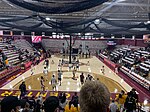The Jacob Leisler Monument is a bronze sculpture created by American artist Solon Borglum and located in the city of New Rochelle, in Westchester County, New York. The monument was erected by the Huguenot Chapter of the Daughters of the American Revolution, and the Huguenot Association of New Rochelle to the memory of Jacob Leisler, 17th-century advocate of the Huguenot settlers and said to be the first chief executive of the province of New York to draw his power directly from the people. The unveiling of the statue on June 24, 1913, was the principal event in the celebration of the 250th anniversary of the founding of New Rochelle. The monument, cast by the Roman Bronze Works, is the only existing statue of Leisler.
Jacob Leisler was German-born and came to North America in 1660 as a soldier in the Dutch West India Company's service. Settling in New Amsterdam (New York), he left the company and prospered in the tobacco and fur trades, becoming a wealthy merchant and being appointed to several public offices in the city, such as justice of the peace and judge. Beginning in 1689, following the English Revolution in 1688 and accession of the Protestant rulers William III and Mary II, he led an insurrection dubbed Leisler's Rebellion, with popular support among the common people, ultimately seizing control of the city and colony from Jacobite officials previously appointed under the deposed King James. He appointed himself as acting Lieutenant Governor of the Province until the governor appointed by William and Mary finally reached New York in March 1691. During this period, he had purchased land from Pelham Manor, reserving a portion to help create the Huguenot settlement of New Rochelle in 1689. He refused to turn over power to a newly appointed lieutenant governor in 1690.Leisler in 1691 was arrested and tried by his personal and political enemies on charges of felony and treason to William III and Mary II, for refusing to give up power to their appointed Lieutenant Governor before the full governor arrived several months later. He and his son-in-law were both executed. Many thought the trial was unjust. Four years later, Parliament reversed the conviction, clearing Leisler's name and restoring his estate to his heirs. They exonerated the late friend of the Huguenots.





